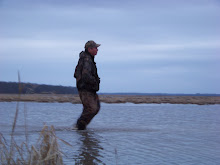"Doctor's Orders"
“No problem,” I offered. “We can handle that.”
My assurance was followed by a brief moment of silence. Then my wife sighed and added, “There’s one more thing. You’re not going to like it. The doctor said absolutely no more fires.”
“I’m sorry,” I retorted. “It sounded like you said no more fires.” I believe I even chuckled.
“I did,” she said. “I told the doctor you wouldn’t be happy. I asked him if we could have fires after the kids have gone to bed or just not every night, and he looked at me like I was insane. He said, ‘Your son does not need to be around smoke or fire, except on Christmas Eve or other very rare occasions. Not unless his symptoms improve or he outgrows this.’ Sorry, Honey. Doctor’s orders.”
I’m sure she said something else before we got off the phone, but if you were to walk in and put a gun to my head right now, I would not be able to tell you what it was.
No more fires.
No.
More.
Fires.
Call me simple; call me odd; call me old-fashioned; even call me crotchety; but a steady, unobtrusive fire is among my greatest delights. When August rolls around, I begin thinking of that first far-off break in the weather that will justify the season’s inaugural fire. Come September, I have usually already scouted out suitable water oaks, red oaks and the occasional hickory for cutting up and splitting. I celebrate the discovery of a good piece of fat wood or lighter knot in the woods the same way a Canadian tourist rejoices over discovering a broken sand dollar on the beach. To me, one of the most appealing aromas in the world is the green, pungent scent emitted from freshly split water oak as it surrenders its moisture and begins to dry out in the rack in my garage – which takes up an entire wall.
Between opening day of rifle season in November until well into turkey season every spring, it’s a safe bet that you’ll observe sweet, aromatic smoke rolling from my chimney – even on days when my neighbors are outside in their shirtsleeves. Let them think what they will; but I don’t charge them for the seasonal redolence that wafts through their yards courtesy of my chimney.
On fall and winter days when the sun has set before most folks have left work, my contentment upon walking through the door every evening requires little more than a hug from the kids, a kiss from the CFO and building a fire.
How can I be an outdoor writer without a fire? Aren’t I duty-bound to sit in my leather chair with a bourbon in one hand and my pencil in the other while the fireplace cracks, pops and hisses beside me? I feel as though I’ve been disqualified. What would Gene Hill have done had he been prohibited from sitting beside the fire? Changed tires and checked the oil at an upstate New York service station? A fire both haunts and inspires the spirit of a writer. I have long suspected that the writer’s block I endure in the summer months every year is due not to my relative inactivity and complete lack of motivation because of the stifling heat, but from the absence of a fire in the fireplace.
The doctor’s cruel proscription came just in time for the holidays, too. Yule logs require a fireplace, for Pete’s sake. Egg nog, off-key carols and obnoxious sweaters cry out for a mantle against which to lean. Stockings aren’t hung by the dishwasher with care. Chestnuts roast on an open fire, not in the microwave (Okay, so no one has seen a wild chestnut tree or gathered up chestnuts from the woods in over a century because of the blight, but you catch my drift).
As this has all begun to sink in – only partially, mind you; I hover between denial and rebellion – I have been able to arrive at only one sure, crystal clear, irrefutable, albeit begrudged conclusion: as much as I love to enjoy a good fire on cool fall evenings and cold winter days, I absolutely, unequivocally love my son more. Which leaves only one other matter to address, if the situation doesn’t improve or should I fail to talk some sense into this doctor.
Anybody need any firewood? I have a little more than a cord stacked up in the garage and it ought to be plenty cured by now.
(c) Roger Guilian 2010

